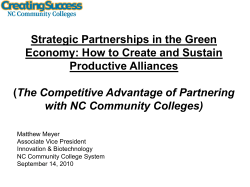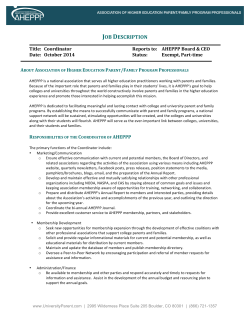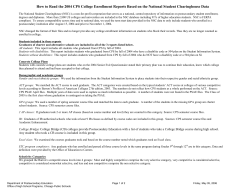
Document 353339
BC’s Colleges: Putting British Columbians First in Line The Situation There are 985,100 job openings forecast by 2022; the largest percentage, 44 per cent, require a college education. Between 2019 and 2022 the demand for college educated workers in BC will outpace supply. The BC Skills for Jobs Blueprint (the Blueprint) highlights the urgency to ensure British Columbians are first in line for jobs in the growing economy. BC’s colleges have a pivotal role to play in developing the highly skilled and educated workforce required for British Columbia to be competitive globally and build a strong and vibrant economy. The importance of a college system was recently demonstrated when the government released data on the 70 occupations in highest demand. BC’s colleges offer training and education for more than three quarters, 76 per cent, of the occupations on the list. Additionally, many students complete their applied degrees or will begin their studies at one of BC’s colleges and then transfer to university in order to complete the remainder of their education. In order to meet the skills shortage, it’s imperative that the college system has a place at the table with government, industry and labour to help address the challenges ahead. With the right education and training plan in place, BC will be more competitive globally and able to seize opportunities in LNG, oil and gas, hydroelectric and other major projects slated for development. Over the last number of years, BC’s colleges have worked closely with government and other partners, to manage extraordinary budget requirements, realize efficiencies and continue to ensure access to programming in high demand areas for all British Columbians. BC’s colleges will continue to look for new and different ways to build capacity through partnerships and collaboration with government, industry, K-‐12 and labour to meet the economic objectives of the province. “There are now over 95,000 BC residents who are not employed because they have not obtained a level of education adequate to meet employers’ needs (but which would have been adequate 20 years ago). The cost of this “access gap” in real GDP (2007 dollars) to BC’s economic potential is up to $4.6 billion annually.” The Conference Board of Canada The Skills & Experience Gap The BC Labour Market Outlook predicts that between 2019 and 2022 the demand for skilled workers will outpace supply resulting in a Skills & Experience Gap. Our aging population, combined with the increasingly higher levels of knowledge and skills needed to be competitive in the global economy, are driving the demand for more highly skilled, job-‐ready college graduates. Already 1 in 3 employers say they cannot find the skilled workers they need to fill jobs however, many in BC remain unemployed or under-‐employed. Additionally, employers are becoming more concerned about the emerging “experience gap” brought about by retiring employees that will affect the outlook for many businesses that rely on experienced employees. With the right level of investment, BC’s colleges can help government address the skills and experience gap and put British Columbians first in line for jobs. BC’s Colleges provides programming for 53 of BC’s top 70 in demand occupations. That’s education and training for 76% of BC’s highest in demand jobs, including: • • • • • • • • • Registered nurses Administrative assistants Administrative officers Carpenters Financial auditors & accountants Accounting technicians &bookkeepers Social & community service workers Licensed practical nurses Early childhood educators • • • • • • • Construction managers Electricians Restaurant & food service managers Welders Steamfitters Millwrights Senior Managers: construction, transportation, production & utilities Foundations for Success BC’s colleges recognize the labour market and budget challenges facing government. The requirement for greater numbers of college graduates in the occupations of highest demand and the increased demand for college programs comes at a time when colleges are trying to manage targeted reductions to operating grants, as well as inflation on operating and instructional services and funding cuts to ESL. The college system continues to develop approaches that will enable each college to respond to regional and provincial labour market requirements. We are mindful of the key role that each college will be expected to fulfill in addressing the labour market requirements of the Province. Collaborations, partnerships and strategies that achieve greater efficiencies are being fully explored. In order to produce the highly skilled, job-‐ready labour force required to ensure the future prosperity of our province the following must be addressed: • Multi-‐year investment plan – to allow our colleges to build capacity and align programming to the objectives set out in the Blueprint. Additionally, the following issues need to be addressed: o Rebalance colleges’ proportionate share of operating funding, mitigate the impact of inflation and address the funding cuts to ESL. o Create incentives for matching programs – to encourage industry to work with colleges to support the objectives of the Blueprint. o Improve technology infrastructure – to enable more online/simulation training, increase access and realize operational efficiencies. • • • Improve facilities and instructional equipment – address the reduction to the annual capital allowance and invest in facilities and instructional equipment (many of which are in desperate need of renewal) that support the priorities of the Blueprint. Enable our institutions to increase capacity in those areas of strategic priority to the college, the region and the province. Make colleges a priority for one-‐time and year-‐end funding allocated to college related programs or services that support the Blueprint. Opportunities for The Province, In Partnership with BC’s Colleges BC's colleges, in partnership with industry, power regional economic activity and provide students with relevant training and education close-‐to-‐home. Our colleges deliver advanced skills and training students need to capitalize on the jobs and careers most in demand. The challenges and opportunities facing our province call for the college system to work closely with government and industry to re-‐engineer education and training to produce the workers with the right skills required to fuel our economy now. For BC to seize opportunities and achieve its full economic potential a well-‐educated and highly skilled workforce is urgently needed. BC’s colleges propose the following strategies to advance the objectives set out in the Blueprint. Each strategy calls for college leadership and collaboration between colleges, other sectors and stakeholders. Our system is committed to working with government, industry and labour to fully realize the success of the Blueprint by producing more educated and skilled workers in high demand occupations that are critical to the economic prosperity of the province. The following strategies align with the three primary objectives of the Blueprint and call for collaboration and partnership with government, industry and labour. 1. Provide A Head-‐Start To Hands-‐On Learning Through Collaboration & Partnership With K-‐12 • • • • • • Well-‐educated and highly skilled workers are essential to BC’s economic growth and prosperity. BC’s colleges are BC’s lead education and training provider and will be the primary provider of skilled workers to support the objectives laid out in the Blueprint. BC’s colleges graduate students – nurses, business managers, tradespeople, paraprofessionals, healthcare technicians, and other highly trained and educated students – who are job-‐ready, career-‐oriented and equipped with the advanced skills required to take on the challenges of the new economy. In order to mitigate the looming Skills & Experience Gap, BC needs to accelerate the transition of students from K-‐12 to post-‐secondary and fast track them into the workplace to meet projected labour shortages. There is a strong history of regional collaborations between K-‐12 and post-‐secondary institutions across the province. Now is the time to invest in a province-‐wide framework that will encourage school districts and colleges to work together to match students with the right advanced skills and job training for the careers most in demand. BC Colleges Select Standing Committee on Finance Submission – October 15, 2014 3 BC Colleges Transition Strategy Investment by government in a BC Colleges Transition Strategy would encourage more students to pursue post-‐ secondary education while in high school and allow students to transition into post-‐secondary or the workplace faster with the job-‐ready skills required. Specifically this strategy will: • • • • • Develop a Transition Pilot with key stakeholders in K-‐12, post-‐secondary and industry to transform Dual Credit and fully optimize ACE-‐IT programs in BC. Focus on careers most in demand, remove barriers to entry and examine best practices to develop a framework with the intent to expand Dual Credit and ACE-‐IT throughout BC. Increase the number of Dual Credit and ACE-‐IT program spaces in high demand areas such as nursing, business, trades, engineering and information technology. Provide multi-‐year funding and incentives to implement the new framework and ensure there is the right infrastructure for ongoing K-‐12 and post-‐secondary collaboration. Strategically coordinate resources to: o Encourage K-‐12 and post-‐secondary to create more opportunities for the seamless and successful transition of students to employment. o Find opportunities within the school districts and post-‐secondary to make the best use of existing resources, facilities and faculty. Transformation of the existing Dual Credit and ACE-‐IT programs will help Government meet the targets for skills and jobs as set out in the Blueprint. ASK: • $500,000 for development and piloting a transition framework • $3 million annual, multi-‐year commitment for implementation of BC Transition Strategy 2. Build Stronger Partnerships With Industry & Labour To Benefit Communities Across BC • • • • • • BC’s network of community colleges has over 60 locations and provides access to quality and affordable education close-‐to-‐home. Educating students close-‐to-‐home results in stronger communities both economically and socially. Working closely with industry and labour, BC’s colleges respond to local labour market needs and develop relevant programming. Baby boomers are retiring in greater numbers. This results is a significant experience gap place, one that will have far-‐reaching effects on BC’s future economic growth. Colleges must work together with industry and labour to build partnerships that ensure students acquire the right advanced skills and training to combat the looming Skills & Experience Gap. Improving collaboration and cooperation with industry and labour must be a priority. “… although future needs for resource-‐sector workers may be considerable (e.g., oil and gas drillers1), these do not reflect the current and anticipated realities for most employers—which are still largely shaped by the prospect of looming retirements of key personnel (the emerging “experience gap”), and the need for experienced individuals able to handle the business aspects of their organizations in the years to come.” The Conference Board of Canada BC Colleges Select Standing Committee on Finance Submission – October 15, 2014 4 Learning Partnership Fund This fund is intended to encourage labour and industry to work with BC’s colleges to develop an effectively trained and mobile workforce solution to the Skills & Experience Gap. • • • • • The Learning Partnership Fund will be a collaborative arrangement between post-‐secondary, industry and labour to align and support industry needs and governments’ objectives for skills training and to address issues around workforce experience, mobility, employability of graduates, just-‐in time skills training and the use of existing equipment and infrastructure. The partnership will allow students to gain hands-‐on experiential learning via co-‐op placements, apprenticeships or in the classroom with industry collaboration. The fund will assist institutions to deliver relevant programming co-‐operatively with industry and labour and produce a targeted number of graduates in high-‐demand occupations that match labour market needs. In order for students to be trained effectively on the most up-‐to-‐date equipment, the fund will have a matching equipment component whereby industry contributions to the matching fund may include direct financial contributions as well as in-‐kind contributions of equipment or facilities. The fund will also be aligned with the Canada Jobs Grant program to maximize access to federal funding. ASK: • $50 million endowment to be allocated over the next 5 years, targeted to college programs that support the BC Skills for Jobs Blueprint. Applied Research & Innovation • • • • Over the past decade, SMEs have successfully partnered with BC’s colleges to design and execute applied research that in turn drives innovation and improves productivity. The federal government has recognized the importance of this form of partnership by giving colleges access to Federal grants under NSERC and SSHRC. Currently however, BC is receiving only 8 per cent of Federal funding well below the 13 per cent provincial allocation resulting in a funding shortfall of over $3.8 million. The provincial government needs to recognize the value of this type of research and introduce an action plan to enable our institutions to be more competitive in pursuing federal funding for research and innovation as it will benefit economic growth and prosperity in every region of our province. ASK: • Introduce similar capacity building program used in Alberta, Ontario and Quebec by allocating one time funding of $3 million for 2015/16 to be used to leverage federal funds for BC. 3. Shift Education & Training To Better Match Jobs In Demand • • • BC’s colleges offer individualized attention, flexible programming and relevant training that transforms lives and transitions students into the workforce quickly. Our colleges are responsive to the ever-‐changing workforce Approximately 90 per cent of landscape and provide students with opportunities to acquire specific BC’s college graduates skills and knowledge as well as the ability to think critically, act successfully transition to the socially and adapt to new challenges. workforce within 6 months of graduation. Additionally, BC’s colleges teach literacy and essential skills to help BC Colleges Select Standing Committee on Finance Submission – October 15, 2014 5 • • • • • people evolve with their jobs, be more productive and adapt to workplace change. However, to meet labour force demand there must be a fundamental shift in how education is delivered to adult learners, immigrants and Aboriginal learners who are key to mitigating the Skills & Experience Gap. In order to meet the future labour force demand, British Columbia must look to under-‐represented groups and ensure they have the training and education required. A study commissioned by the federal government found that nationally 40 per cent of the workforce and 50 per cent of students entering a BC college lack the essential skills to be successful in their post-‐secondary training and productive in their chosen occupation. Addressing this particular gap is fundamental to meeting the challenges laid out in the Blueprint. This means overhauling how adult education is delivered in BC and empowering BC’s colleges to work with the K-‐12 system, industry and key stakeholders to develop a province-‐wide strategy to get more people to complete education and training and successfully transition to work. “Essential skills are important for a variety of reasons. When individuals lack essential skills, their ability to meet the basic demands of their roles may be diminished—and they may be less likely to receive other forms of workplace training.” The Conference Board of Canada BC Adult Employability Pilot • • • • • • • As a system transform and re-‐engineer Adult Basic Education (ABE) to BC’s colleges, in educate adults with essential skills for employability to increase their partnership with industry successful transition to the workplace. training schools, self-‐ Match ABE programming with careers in high demand and the supply funded an Essential Skills required by industry, specifically in critical areas such as business, pilot that demonstrated administration, finance, trades and healthcare. the opportunity to increase Create pathways for students – especially Aboriginal, immigrant and student success and disabled learners – to transition quickly to the job market with real transition to the workplace skills, such as critical thinking, problem solving, oral communication making graduates more and literacy. job-‐ready and productive. Year 1 – Steering Committee – labour, industry, government, K-‐12, post-‐secondary – undertake a pilot that will re-‐engineer ABE to ensure better outcomes. Year 2 – Secondary funding – expand and embed essential skills into specific programs that align with high-‐ demand careers. Access federal funding via the Canada Jobs Grant to produce more effective education and training for adults to transition successfully to the workplace. Explore opportunities to better align funding to outcomes and provide a more structured, coherent education experience that recognizes milestones and celebrates student success. ASK: • $5 million in targeted ongoing funding that supports transformational initiatives that tie adult education programming and outcomes to the job market. BC Colleges Select Standing Committee on Finance Submission – October 15, 2014 6 Investment in BC’s Colleges Provides An Excellent Return While BC’s colleges face challenges with capacity and financial sustainability, we are committed to working with the provincial government to realize the objectives of the Blueprint. Increased investment will ensure BC's colleges can prepare the highly skilled workforce needed to fill the Skills & Experience Gap, as well as build strong and vibrant communities and enhance the province's competitive advantage. BC’s colleges are the most accessible and affordable post-‐secondary education pathways for all British Columbians. • Tuition cost at a BC college vs. a BC university: 35 – 45% less. • For every $1 spent: o $3.10 returned in lifetime earnings for students. o $15.40 returned in added income and savings to society. o $2.40 returned in added taxes and savings to taxpayers. • $7.8 billion is the combined annual contribution of BC’s public colleges and their graduates. • 4.2% of BC’s GDP is the contribution from BC’s colleges and their students. Similar in size to the GDP contributions of sectors like Finance and Food Services. • BC’s college graduates are reducing the skills gap and providing an educated and skilled workforce. • Continued investment in BC’s colleges will result in a better standard of living, reduce social costs, ensure labour market demands are met and create vibrant and sustainable communities throughout BC. BC Colleges Select Standing Committee on Finance Submission – October 15, 2014 7
© Copyright 2025









